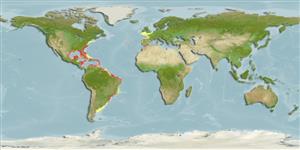Bivalvia |
Venerida |
Veneridae
Environment: milieu / climate zone / depth range / distribution range
Ecology
Benthic; depth range 0 - 100 m (Ref. 3446). Tropical
Atlantic Ocean: Bermuda, Brazil, USA, UK and North America.
Length at first maturity / Size / Weight / Age
Maturity: Lm ? range ? - ? cm Max length : 4.8 cm TL male/unsexed; (Ref. 3446)
Life cycle and mating behavior
Maturity | Reproduction | Spawning | Eggs | Fecundity | Larvae
Members of the class Bivalvia are mostly gonochoric, some are protandric hermaphrodites. Life cycle: Embryos develop into free-swimming trocophore larvae, succeeded by the bivalve veliger, resembling a miniature clam.
Rosenberg, G. 2005 Malacolog 4.1: A Database of Western Atlantic Marine Mollusca. [WWW database (version 4.1.0)] URL http://www.malacolog.org/ (Ref. 3446)
IUCN Red List Status
(Ref. 130435: Version 2025-1)
CITES status (Ref. 108899)
Not Evaluated
Not Evaluated
Threat to humans
Human uses
| FishSource |
Tools
More information
Trophic EcologyFood items (preys)
Diet composition
Food consumption
Predators
Population dynamicsGrowth
Max. ages / sizes
Length-weight rel.
Length-length rel.
Length-frequencies
Mass conversion
Abundance
Life cycleReproductionMaturityFecunditySpawningEggsEgg developmentLarvae PhysiologyOxygen consumption
Human RelatedStamps, coins, misc.
Internet sources
Estimates based on models
Preferred temperature
(Ref.
115969): 22.1 - 27.9, mean 25.8 (based on 436 cells).
Fishing Vulnerability
Low vulnerability (10 of 100).
